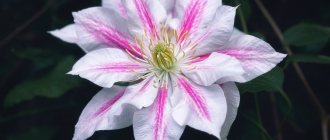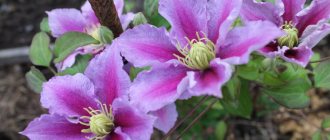Plants » Flowers
0
300
Article rating
Kira Stoletova
When looking at clematis Comtesse De Boucho, no one will remain indifferent. This large-flowered liana-like shrub is striking in its appearance and does not involve any particular difficulties in care, for which it is so valued by many gardeners. Even a person without experience is quite capable of achieving success in growing crops if he follows certain standards of agricultural technology.
Comtesse de Boucheau clematis
general description
Clematis Comtesse de Bouchaud is the result of the work of the French breeder Francis Morel, obtained at the end of the 19th century. In common people it is also called “Countess De Bouchot” in honor of a high-ranking lady who at that time owned a large garden in Charles.
The perennial shrub has active growth - the maximum height reaches 3-4 m. However, due to the weather conditions of Russia, the indicators are more modest - basically, the vine does not exceed 2-3 m.
The shoots are densely leafy, covered with dense, complex-shaped leaves, consisting of 5 pointed-ovate segments.
The bush forms buds on vegetative shoots of the current season. The flowers are quite large in size, reaching 10-15 cm in diameter. The petals are soft pink with a lilac or purple tint, with a slightly corrugated surface and slightly curved edges. Anthers with bright yellow stamens are located in the center.
It enters the flowering phase at the end of June and continues to delight with its appearance until September. A distinctive feature of this hybrid variety is the formation of flower ovaries almost from the base, which sets it apart from other representatives of this culture.
Landing Features
Despite the unpretentiousness of clematis, its planting in open ground should be approached with responsibility, which is due to the ability of the flower to grow in one place for up to 20 years without the risk of loss of decorativeness.
Clematis comtesse de boucheau photo and description
Deadlines
The optimal time for the event is considered to be spring (late April-early May), especially when cultivating the plant in an area with a harsh climate.
Planting in autumn is also allowed. In this case, it is recommended to start work in September-October, at least 30 days before frost.
Selecting a location
This variety is not susceptible to fading in direct sunlight, so the shrub can be placed both in well-lit corners of the garden and in partial shade. In this case, you will have to take care of protecting the bush from the effects of drafts and gusts of wind.
When placing next to a garden building or fence, a step of 0.5 m should be maintained. This will ensure the necessary level of insolation and prevent excess moisture from entering the structures after rain.
Another important point is the occurrence of groundwater. If they are located close to the surface, an artificial embankment with a height of at least 15 cm is constructed in order to prevent possible rotting of the root system.
Experienced gardeners advise preparing the planting hole in advance, about 2-3 weeks in advance. At the bottom of the recess, a drainage layer of expanded clay or crushed stone must be distributed, and a partial soil mixture is poured on top of it. In addition to garden soil, the substrate should contain either ash in the case of an acidic environment, or pine needles or sawdust if it is necessary to leaching the soil.
Additionally, compost, plant humus or mineral complexes are added to the hole to increase soil fertility. The use of fresh manure before direct planting is strictly prohibited; it can only be applied in the previous season, several months before the procedure.
Seedling preparation
In a healthy seedling:
- there are no traces of mechanical damage or disease;
- elastic roots (at least 5 pieces) about 0.5 m long;
- On shoots 5 cm high there are at least 2 growth buds.
If the roots of the plant along with the earthen ball are too dry to restore elasticity, they are placed in water for several hours.
Landing technology
- Dig a planting hole with a depth and a diameter of 0.6 m. When planting groups of shrubs, maintain the distance between the holes, taking into account their dimensions in adulthood.
- A drainage cushion is constructed from crushed bricks, pebbles, expanded clay or crushed stone.
- Fill with partially prepared soil mixture, forming a mound.
- Stick in a support. If you do this after the process is completed, the risk of injury to the plant’s root system increases.
- Disinfect the soil with a weak solution of potassium permanganate.
- Place the seedling in the middle and straighten the roots.
- Fill the remaining space with soil. In this case, a small recess about 10 cm deep is left, which is gradually filled with substrate throughout the season.
- Watered. Mulching.
Description of clematis variety de Boucho, planting scheme and care
Clematis is a luxurious decoration for the garden. Liana fits beautifully into landscape design.
This culture is famous for its variety of shades and sizes of flowers. But clematis Comtesse de Boucheau, which was bred by breeder Morel more than a century ago, has gained particular popularity.
The variety is suitable for cultivation by both experienced and novice gardeners. Positive reviews of clematis Comtesse de Bouchaux are due to the attractive features of the plant. The flower is resistant to low temperatures and diseases. The variety is unpretentious and undemanding in care.
The variety has gained popularity as a large-flowered vine with voluminous pink buds. The variety was obtained by crossing. As a result, the description of clematis Comtesse de Boucho allows us to indicate the unique decorative properties of the plant.
- rich and colorful colors of flowers in the pink-lilac spectrum;
- crop height is about 2.5-3 meters;
- long and abundant flowering, which lasts from early summer until September;
- the diameter of the inflorescences is from 10 to 15 cm.
The plant belongs to the fourth group of winter hardiness, which indicates the ability to withstand frosts down to -35 degrees. Many gardeners are interested in what pruning group for clematis Comtesse de Boucho and what other features of the crop are. The variety is included in the third “block”, which is considered strong. In addition, it is a profusely flowering and healthy species. But it is worth considering that the plant develops for quite a long time. You can learn how to grow clematis from seeds here.
Among other features of this clematis variety, it is worth noting some nuances of flower formation. The edges of the petals curl down slightly, creating an attractive roundness. They usually create 6 sepals. Their contours are wavy. Flowers on a plant are most often arranged in groups of 3. The largest number of them is formed in the upper part of the bush. Clematis also has light yellow anthers.
A reliable stand for clematis will allow it to bloom confidently for a long period without the risk of deforming the bush. With the help of this plant you can effectively decorate your garden plot or house.
Even the most boring and inexpressive area on the territory will be transformed and sparkle with new colors. The structure of the variety is similar to grapes. That is why it is so important to leave enough free space for it to fully grow and accommodate. According to reviews from gardeners, the lashes of Comtessede Bouchaud are easily directed in the right directions, and there are no problems with the distribution of the flower. The variety grows quite slowly, but with proper care it can decorate the garden for up to 20 years.
Many gardeners are interested in how to plant clematis Comtesse de Boucho? The procedure is not complicated.
That is why the hole must be large enough. At its bottom it is worth putting some manure, leaves and mineral compounds in layers. It is also recommended to pour a hot solution of potassium permanganate into the hole prepared for clematis. It will disinfect the soil.
After half an hour, you can plant the bush. It is sprinkled with earth on top. It is equally important to lightly irrigate the soil with warm water. The process of planting a flower should be completed by forming a layer of mulch.
Another question that worries many gardeners is how to propagate clematis correctly.
The most convenient method of propagation is cuttings.
You can take material from a bush at the age of 3-4 years. The lower cut of the cutting is made at an angle of 45 degrees. The top one should be perfectly even. It is optimal if it is about 2 cm higher than the node. The material takes root in a sand-peat mixture. The area should be slightly shaded. Before immersing in the soil, it is recommended to treat the cutting with a solution of Zircon or Epin. This will increase the survival rate.
You can also use layering, but propagating clematis by seeds at home will be more effective. To achieve good results, it is recommended to carry out stratification. To do this, the seed is immersed in a soil mixture consisting of soil, sand and peat. It must be maintained at a temperature within 5 degrees. The optimal place for the procedure is the refrigerator. This preparation ensures a high percentage of germination.
As for caring for the Comtesse de Boucheau plant, it is considered minimal.
This indicates that last year's shoots will be the first to bloom. Gardeners from Europe prefer to prune according to the third type. This procedure is performed at intervals of 2-3 years. Pruning should be done 15-40 cm from the soil surface, above 2-3 pairs of buds.
Comtessede Bouchaud is unpretentious in soil composition. This flower needs moderate watering. The main thing is to prevent rainwater from entering the crop. It is recommended to form a thick layer of mulch around the root system. It will protect the plant from freezing. Despite the capriciousness of other varieties of this crop, clematis diseases and their treatment are not a problem in this case. Comtesse de Boucheau is resistant to most ailments.
Exquisite and luxurious flowers have always attracted special attention. Seeing a wall of clematis flowers in front of you, rarely anyone is able to remain indifferent. Among their varieties, some do not require complex care and are easy to grow for beginners. This is exactly what the flowers of clematis de Boucho are.
The stem of comtesse de bouchaud is a vine 3-4 meters long. When this flower is grown in Russia, it has a smaller size - 2-3 meters.
The leaves of this plant have a complex shape. They are dense, consisting of five pointed ovoid leaves. The peduncles are long, they can reach 18 centimeters. Flowers have a diameter of 10-15 centimeters. A large number of flowers bloom on one stem.
Clematis is not a double flower. It has 6 elliptical sepals. The color of this variety is pink with a purple tint. The petals appear ruffled with veins of a deeper purple color. The color of the stamens is bright yellow.
The flower can produce seeds, but it will not be possible to grow flowers from them. In bright sunlight, flowers do not burn out.
The flowering period is from July to September.
The formation of flowers occurs along almost the entire length of the plant: the lowest flowers are located at a height of 20-25 centimeters along the entire length of the shoots of the plant.
The lifespan of clematis de Boucho is 20 years.
This species is one of the most prominent in the Clematis family. Comtesse de Bouchaud has a history that goes back over a hundred years.
It was bred by the French florist Francis Morel. This variety received an award from the Royal Horticultural Society. It owes its name to the Countess de Bouchot, famous for her luxurious garden in Chasselas in south-eastern France.
Growing
Although this flower is unpretentious, the planting procedure must be taken carefully. This plant lives for a long time and therefore it is better to do everything correctly right away than to correct mistakes made later.
The time for planting seedlings can be late spring or early autumn. However, there are important features here:
- If planted in the spring, the flowers have more opportunity to grow and become established before winter sets in. However, when planting, you need to be careful with the roots, as they can be easily damaged at this time.
- In the fall, planting should be done no later than a month or two before the first frost. This is necessary due to the fact that in order to successfully survive the winter, Clematis needs time. However, when planted in autumn, seedlings take root more easily than in spring.
READ MORE: Wardrobe for the bedroom 126 photos built-in radius for clothes bedside hanging and other options large wardrobe
Selecting a location
So that Clematis de Boucho develops well. The landing site must meet the following conditions:
- The plant loves plenty of sunlight throughout the day. Shading is allowed provided that it lasts no more than half of the daylight hours.
- Where these flowers grow there should be no draft or strong wind.
- It is necessary to take into account the depth of groundwater. They should not be located too close to the surface. If this condition cannot be met, an additional mound of at least 15 centimeters high is made for the flowers.
- It is necessary that there is no fence or wall of the house closer than 50 centimeters.
It is necessary to ensure that water from the roof does not flow onto the flowers in rainy weather.
Soil preparation
The soil should be well permeable to air and water. Clematis likes to have enough nutrients to grow.
Acidic soils should be avoided. If there are no other possibilities, then they can be used provided that wood ash or lime is added.
In order for the plant to grow healthy, you need to choose the most suitable seedlings. To do this, it is recommended to follow the following:
- You need to carefully inspect them and make sure there are no mechanical damages.
- If there are traces of diseases, it is better not to use such seedlings.
- On a shoot that is 5 centimeters long, it is necessary to have at least two buds. They must be unblown.
The total length of the roots cannot be less than 50 centimeters. The number must be at least five.
Planting scheme
It is recommended to prepare pits for planting clematis in advance - several weeks in advance. The width, length and depth should be 60 centimeters.
It is important to prepare the planting mixture correctly. For this you need to use the following:
- It is necessary to take equal parts of soil and humus.
- For each hole, add 3-4 kilograms of sand, 400 grams of dolomite flour and 150 grams of superphosphate.
Before planting, pour a small mound of the prepared mixture into the hole. The roots of the seedling are carefully straightened, placed in the prepared hole and the rest of the planting mixture is added.
Care
Watering
Clematis have a positive attitude towards frequent soil moisture. Irrigation should be carried out taking into account the weather conditions of the region.
Clematis comtesse de boucheau description
In moderate climates, the shrub is watered once a week; during hot periods, the time period is reduced by 2-3 times. In this case, it is recommended to apply the liquid not only at the root, but also to spray it on the above-ground part of the plant.
Feeding
If the required amount of fertilizer was applied during planting, there is no need to additionally feed clematis this season.
After a year, they begin to fertilize the bush at intervals of 1-2 times a month, alternating organic matter and mineral complexes. Stop feeding the vine with phosphorus-potassium preparations at the end of September, and with nitrogen preparations in mid-summer.
Mulching
Mulching the space around the trunk helps keep the soil moist and protects the root system from overheating and hypothermia, and also stops the growth of weeds.
Peat, sawdust, crushed tree bark or plant residues are used as consumables. It is not recommended to use straw for these purposes, because it attracts rodents to the plant.
Trimming
Comtesse De Boucho belongs to the third pruning group, which involves a radical haircut before the onset of cold weather. In regions with a harsh climate, it is customary to cut off the branches of the plant at the base; in regions with temperate and warm climates, 2-4 growth nodes are left. In this case, the cut is placed directly above the kidney.
Additionally, throughout the entire growing season, damaged and wilted segments are completely removed.
Shelter for the winter
At the end of the autumn pruning, the vine is covered. First of all, the circle around the trunk is covered with a fairly dense layer of mulch from plant humus or peat, then a wooden box is installed. Spruce spruce branches or leaf litter are spread on top and covered with agrotextiles.
In the spring, such a shelter must be removed in time so that Clematis does not suffer from overheating. It is better to do this in stages over several weeks, first removing the artificial turf and then clearing the soil of the old mulch.
Clematis Comtesse De Boucho
As for other features of this variety, it is worth noting the flowering of clematis. This process usually begins in June or July. It continues until August and early autumn. Everything here depends on weather and climatic conditions. But Comtesse de Boucheau retains the rich green tint of its leaf blades throughout the season.
Comtesse de Boucheau is frost-resistant and unpretentious to grow
When growing such clematis, many gardeners are interested in whether the variety belongs to a certain pruning group.
Attention! The Comtesse de Boucho variety is classified in the fourth winter hardiness group. This suggests that the plant can withstand temperatures down to -35 degrees. But the “category” of pruning clematis is the third.
Countess Bouchot is considered a fairly strong and robust variety of clematis. This is a unique species that is characterized by:
- Abundant flowering.
- Good health.
- Slow growth.
To grow clematis you need support
When planting such a plant, it is very important to remember that it is a perennial. That is why you need to leave enough free space around it, and the planting hole should be very deep and wide.
Clematis Comtesse de Boucho is a luxurious flower with which you can transform your garden area. At the same time, no particular difficulties arise when growing a flower. The main thing is to create support.
| Parameter | Characteristic |
| Genus | Clematis or Clematis |
| Growth form | bush liana |
| Type | Large-flowered |
| Group | Jacquemin |
| general characteristics | An unpretentious climbing plant that is resistant to disease, cold and pests |
| Purpose | Vertical gardening, decor |
| Life cycle | Perennial |
| Reproduction methods | Seeds, cuttings, dividing the bush, layering |
| Shoot length | 3-4 m |
| Flowering type | On the shoots of the current year |
| Flowering time | July-September |
| Flower sizes | 10-15 cm in diameter |
| Flower coloring | Lilac-pink |
| Trimming group | 3rd (heavy pruning required) |
| Frost resistance | High (can withstand temperatures down to −35 ℃) |
| Sustainability | Does not tolerate stagnant water. Resistant to viruses, fungal diseases and pests, moderately affected |
| Inclusion in the State Register of the Russian Federation | Turned off |
Another name for it is “Countess Bouchot”. The variety was bred more than 100 years ago by the famous breeder F. Morel through interspecific crossing, due to which the plant is amazingly resistant to many negative external factors. Clematis "Comtesse de Boucho" amazes with its abundant and long flowering and amazing life expectancy: the shrub can grow in a garden plot for about 20 years. What is this amazing plant?
Description of the variety
This type of clematis boasts a relatively high growth rate - in one season its shoots grow up to 3-4 meters in length. The shrub produces a huge number of lilac-pink flowers, reaching a diameter of 10-15 cm. The flowers of the vine do not fade in the sun, and its delicate purple petals are set off by numerous colorful yellow stamens. The petals have a corrugated shape, their edges are slightly curved downwards.
The plant blooms for a long time, from July to September, buds appear already in the first year after planting. The shrub feels great both in open sunny areas and in partial shade. It retains the rich green color of its leaves throughout the season.
Features of this type of clematis are:
- abundant flowering;
- slow growth of the plant in width;
- high viability (the shrub grows well in containers);
- resistance of flowers to direct sunlight.
Subtleties of landing
Lianas of this variety prefer light, breathable soil and are difficult to tolerate stagnation of water and acidification of the soil. Clematis seedlings “Comtesse de Bouchaux” can be planted in a permanent place both in the fall (September, October) and in the spring, when frosts have passed.
Many gardeners recommend choosing seedlings for planting that have at least five roots (total length about 50 cm) and 2 unopened buds on the shoot. In this case, you can be sure that the next season the plant will actively grow and become a wonderful decoration of any garden.
The hole for planting the bush must be at least 60 cm in length, width and depth. Drainage is placed at its bottom, and a mound is formed from the planting mixture, the composition of which directly depends on the condition of the soil. So, for neutral or slightly alkaline soil, adding a mixture of ash and soil will be enough; to acidify highly alkaline soil, add pine needles or fresh sawdust. It is also recommended to apply fertilizers before planting: humus, peat, compost or mineral components.
The plant seedling is buried in a hole so that the root collar is 5-15 cm below ground level. It is advisable to immediately apply a thick layer of mulch to the surface of the earth above the roots. This way the plant will retain moisture in the summer (its roots cannot stand the heat). Before the onset of cold weather, mulching is usually repeated (the layer thickness is increased) to protect against freezing.
The supports to which the vine will cling are installed before planting. The height of the supports must be at least 2 m in height. The type of growth of clematis resembles grapes; it is very important to pay due attention to adjusting the direction of its growth.
Plant care
The main procedures for caring for this shrub are watering, fertilizing and pruning.
All clematis require frequent, abundant watering; due to lack of moisture, their flowers become small and flowering time is reduced. Experienced gardeners recommend watering the plant about 3 times a week, also irrigating the foliage itself. It is important not to overdo it with watering. In conditions of constant dampness, the plant may not only stop blooming, but also die.
In the first year after planting, the shrub does well without fertilizing. Fertilizers begin to be applied in the 2nd year, alternating organic matter with mineral components.
READ MORE: Which heated floor is better to choose: water or electric?
Trimming group
For clematis "Comtesse de Boucheau" the pruning group is the third. This means that before the arrival of winter, the plant must be radically pruned. In cold regions, shoots are usually cut to the ground, and in warmer regions, no more than 2-3 nodes are left on each.
During the entire flowering period, it is also recommended to remove damaged or withering branches of the vine. Although the shrub tolerates frost well, some gardeners recommend covering the area around the plant with peat or humus for the winter, covering it all with dry leaves on top. Similar actions are relevant for regions with cold winters.
This variety of vine is almost not susceptible to diseases. In quite rare cases, a plant may encounter such an unpleasant disease as wilt. When the first signs of wilting of the bush appear, starting from the tops of the stems, diseased shoots should be radically removed and the soil and base of the bush should be treated with a solution of potassium permanganate or foundation.
| Pest | Fighting methods |
| Nematode | Removing infected plants, planting crops that suppress the development of nematodes (dill, parsley, calendula, coriander, Chernobrivtsy) |
| Slugs | Sprinkling the soil with ash, manually getting rid of pests |
| Spider mite and beet aphid | Treatment with insecticides or garlic infusion |
| Window moth, moth | Insecticide treatment |
According to reviews, clematis “Comtesse de Bouchaux” is an unpretentious plant with stunningly beautiful flowers. The bush can be an excellent decoration for any fences, gazebos, walls, and even garden tree trunks.
Reviews from gardeners
I bought these flowers for myself to plant around the gazebo. A designer friend recommended them to me. They all took to it and bloomed magnificently in the first year. In reality they look much more beautiful than in the photo. I recommend!
There are about ten varieties of clematis growing in my garden, but Countess Bouchot is my favorite. In terms of abundance of flowering, no other plant can compare with it. My flowers begin to bloom at the end of June and decorate the garden until the end of August. Last year my husband built special arches, and the plants look amazing on them. What is especially pleasing is that the flowers on the arches are located almost close to the ground; many other varieties of clematis cannot boast of this.
When I bought the bush, I didn’t even think that there would be so many flowers on it! Before purchasing, I didn’t know anything about clematis; I accidentally picked it up at the market. Now this is my favorite plant, easy to care for, completely undemanding. And every year it blooms more and more. Beginning gardeners will definitely love it! In the near future I plan to buy several bushes for my mother.
I planted my bush in a shaded place, because I heard that clematis flowers fade in direct sun. In two years, the branches never grew more than 1.5 meters in length, although on the Internet they write about a length of almost 4 meters. The flowers are like in the picture, although not very large. I’m thinking about transplanting the clematis to a more open area, but I don’t know what will come of it.
From early childhood she spent a lot of time working in the garden; knows firsthand how to properly care for most crops. He prefers to devote his free time from work to relaxing outside the city. Dreams of building his own house. I read a lot of books about caring for garden plants. He willingly shares his knowledge with readers.
Reproduction
To propagate clematis, they adhere to the vegetative method. Seed is only suitable for natural forms, because the bred specimens do not retain the characteristics of the mother plant.
Clematis variety comtesse de boucheau
Cuttings
One of the simplest and most productive ways, thanks to which you can simultaneously get several flowering vines. Specimens aged 3-4 years are taken as the starting plant. A part of the apical shoot about 5 cm in length with 1-2 pairs of buds is cut off from them. Preference should be given to segments located in the inner part of the crown.
After pruning, the bottom of the cutting is treated with a growth stimulator and embedded in a moistened mixture of sand and peat. To speed up the root formation process, polyethylene is stretched over the container, thereby creating a greenhouse effect.
Dividing the bush
Allowed only for propagation of vines over 5 years old. The event is carried out in spring or autumn; during the procedure, part of the rhizome is dug up with a shovel, after which the plot is moved to a new location. Additionally, it is recommended to disinfect the injured segments with a solution of potassium permanganate or any fungicidal agent.
By layering
The option involves digging in vegetative shoots near an adult plant. To do this, make a small hole about 10 cm deep, bend a branch into it and sprinkle it with earth. For greater efficiency and to speed up the rooting process, the shoot is slightly cut in the place where it will be located in the soil.
The resulting seedling is separated from the mother bush in the next season, until then it is provided with standard care for Clematis.
We care, trim and enjoy
Clematis resembles a grapevine in its growth and therefore requires special attention when adjusting the direction of growth.
Advice. For the first year of life, shoots should be protected from direct sunlight, perhaps artificially creating shade.
Pruning is done every third year at a distance of 20-30 cm above the ground. This is necessary for renewal and full flowering. Do not be afraid of such drastic pruning - the plant will grow and immediately bloom in the summer. But you can’t do without fertilizing with nitrogen fertilizers, and after the appearance of green mass - with potassium and phosphorus. For the winter period, this variety requires the third degree of pruning - complete, except for 1-2 buds. You won't have to worry about building shelters.
The variety is absolutely not susceptible to diseases and pests, and nothing will prevent you from enjoying its amazing beauty. It will annually arouse the curiosity and admiration of acquaintances, and perhaps the envy of neighbors.
Diseases and pests
The liana-like Comptesse De Boucher is practically not susceptible to diseases or insect attacks. However, in rare cases, a gardener may encounter a number of problems that are best addressed at the first symptoms.
| Problem | Signs | Prevention | Treatment |
| Rust | Red, convex spots/striations on the underside of leaves; on the outside they look like yellowish blotches. The leaf blades dry out and fall off. | Keep the site clean, promptly remove plant debris, treat it with fungicides, and adhere to agrotechnical standards. | Folk remedies: dissolve 1 aspirin tablet in 4 liters of water, 1 tbsp. sunflower oil and soda, 1 tsp. dishwashing detergent (sprayed once every 7 days). Purchased drugs: Baktofit, Bordeaux mixture, Kuproxat, Medex, Cumulus, Vectra, Strobi, Azophos, Pencozeb. |
| Viral mosaic | Irregularly shaped spots from pale yellow to rich green, development is suspended, young shoots and leaves dry out. | When planting, adhere to the recommended scheme, prevent active growth of weeds, use disinfected tools for pruning, | When a disease occurs, the crop is completely destroyed by burning, because there are no effective means to combat mosaic. |
| Wilt | As the disease progresses slowly, the surface between the veins of the leaf blades acquires a brown tint. Over time, the spots spread over all the leaves, the plant stops in development, the shoots lose their elasticity and bend in an arc. | Disinfect the soil before planting and periodically treat it with Agate or Trichoderma. Adhere to watering regimes and dosages of nitrogen-containing preparations. Do regular weeding and loosening. | At the initial stage, Fundazol, Benlat, Topsin-M, Vectra are used. In case of large-scale damage, the plant is disposed of. |
| Powdery mildew | A white coating with visible drops appears primarily on the lower parts of the bush. | Nitrogen fertilizers are applied moderately, the substrate is not allowed to become waterlogged, sanitary pruning is carried out in a timely manner, and sprayed with fungicides or Bordeaux mixture. | Remove all affected areas, irrigate the crown abundantly with fungicidal preparations, while covering the soil. Systemic agents: Quadris, Amistar extra, Pure color BAU 700, Skor, Vitaros, Thiovit Jet, Topaz. |
| Gray rot | Gray dusty coating of fluffy texture, loss of leaf turgor and typical color, rapid wilting. | Maintain moderation in watering, avoiding excessive waterlogging. Refrain from crowding plantings and thickening the green mass. | In spring, treat with a solution of Bordeaux mixture. |
| Nematode | The plant is stunted and the leaf blades curl in hot weather. | Calendula officinalis, marigolds, and rudbeckia are planted nearby. promptly dispose of plant residues after weeding and adhere to recommended watering standards. | Nemaphos, Dimethoate, Vidat, Nematofagin |
| Spider mite | A thin pale cobweb on the underside of the leaf blades, whitish inclusions. | Avoid overdrying the soil (mites spread more in dry climates), spray with garlic infusion. | Iskra-Bio, Kleschevit, Thiovit-Jet, Fitoverm, Fufanon-Nova. |
| Aphid | Leaves curl, buds and stems become deformed, growth is stunted, and a sticky coating appears on the surface. | Hoverflies are attracted to the garden by sowing carrots, fennel, parsley, and dill in the area. Place pots of sawdust in flower beds to attract earwigs that feed on aphids. In the process of feeding, a balance is maintained; the insect prefers to settle on overfed or weakened crops. | Folk remedies: infusion of onion, garlic, hot pepper, tomato tops, tansy, wormwood, tobacco. Purchased drugs: Biotlin, Tanrek, Alatar, Fufanon, Eforia, Tiara, Confidor, Doctor, Iskra Zolotaya, Zubr. |
Use in landscape design
In landscape design, the Comtesse De Busho variety can be used as an element for vertical gardening of any building: gazebo, fence, residential building, arch. Clematis also looks great near old trees or in a group with other decorative flowers, such as climbing roses.
Clematis comtesse de boucheau photo
Attention to the soil
For Comtesse de Bouchaux, it is worth preparing a special soil composition that does not fail gardeners who are already growing it. Should be taken in equal parts:
- Earth;
- sand;
- humus;
- peat;
The plant needs support
- 100 g wood ash;
- 100 g of complex fertilizer.
The de Boucho variety is very favorable to the application of organic fertilizers. But the acidity of the soil needs to be reduced. This is exactly what the addition of wood ash is aimed at.
If you have just purchased this variety, then before rooting the seedling, you should analyze the condition of the root system. Many gardeners recommend placing the root in water for 2-3 hours after purchase to restore elasticity and vitality.
When clematis is planted in open ground, you should dig a hole for planting much deeper than you are used to. Sequencing:
- Organic matter (manure), grass or leaves are laid out in layers.
- Add mineral fertilizers (nitrophoska or analogues).
- A small amount of prepared land.
- Disinfect with a hot solution of potassium permanganate.
- Only after an hour can you plant, pouring the remaining soil mixture.
- Mulching is a must.
Pay attention to the composition of the soil











